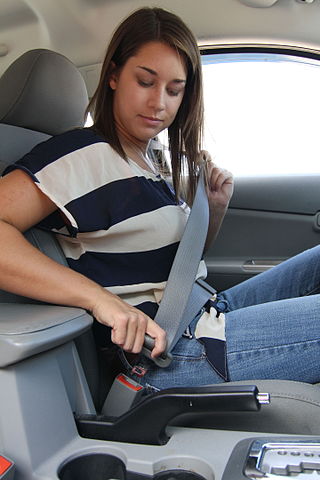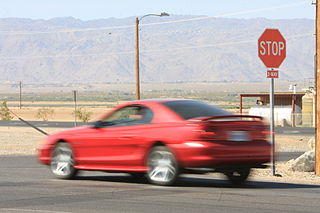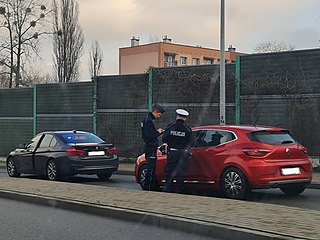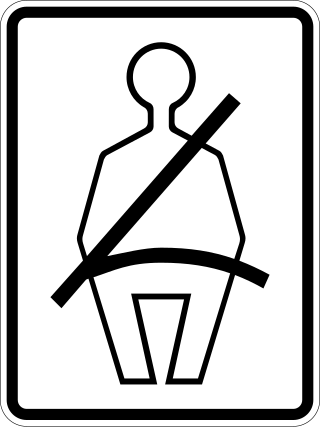
A seat belt, also known as a safety belt or spelled seatbelt, is a vehicle safety device designed to secure the driver or a passenger of a vehicle against harmful movement that may result during a collision or a sudden stop. A seat belt reduces the likelihood of death or serious injury in a traffic collision by reducing the force of secondary impacts with interior strike hazards, by keeping occupants positioned correctly for maximum effectiveness of the airbag, and by preventing occupants being ejected from the vehicle in a crash or if the vehicle rolls over.
Drunk driving is the act of operating a motor vehicle with the operator's ability to do so impaired as a result of alcohol consumption, or with a blood alcohol level in excess of the legal limit. For drivers 21 years or older, driving with a blood alcohol concentration (BAC) of 0.08% or higher is illegal. For drivers under 21 years old, the legal limit is lower, with state limits ranging from 0.00 to 0.02. Lower BAC limits apply when operating boats, airplanes, or commercial vehicles. Among other names, the criminal offense of drunk driving may be called driving under the influence (DUI), driving while intoxicated or impaired (DWI), operating [a] vehicle under the influence of alcohol (OVI), or operating while impaired (OWI).

A school bus is any type of bus owned, leased, contracted to, or operated by a school or school district. It is regularly used to transport students to and from school or school-related activities, but not including a charter bus or transit bus. Various configurations of school buses are used worldwide; the most iconic examples are the yellow school buses of the United States which are also found in other parts of the world.

A moving violation or traffic violation is any violation of the law committed by the driver of a vehicle while it is in motion. The term "moving" distinguishes it from other motor vehicle violations, such as paperwork violations, parking violations, or equipment violations. The United States Department of State makes reference to moving violations in its enforcement guidance.

Risk compensation is a theory which suggests that people typically adjust their behavior in response to perceived levels of risk, becoming more careful where they sense greater risk and less careful if they feel more protected. Although usually small in comparison to the fundamental benefits of safety interventions, it may result in a lower net benefit than expected or even higher risks.
Seat belt legislation requires the fitting of seat belts to motor vehicles and the wearing of seat belts by motor vehicle occupants to be mandatory. Laws requiring the fitting of seat belts to cars have in some cases been followed by laws mandating their use, with the effect that thousands of deaths on the road have been prevented. Different laws apply in different countries to the wearing of seat belts.

A red light camera is a type of traffic enforcement camera that photographs a vehicle that has entered an intersection after the traffic signal controlling the intersection has turned red. By automatically photographing vehicles that run red lights, the photo is evidence that assists authorities in their enforcement of traffic laws. Generally the camera is triggered when a vehicle enters the intersection after the traffic signal has turned red.

A traffic stop, colloquially referred to as being pulled over, is a temporary detention of a driver of a vehicle and its occupants by police to investigate a possible crime or minor violation of law.

The National Traffic and Motor Vehicle Safety Act was enacted in the United States in 1966 to empower the federal government to set and administer new safety standards for motor vehicles and road traffic safety. The Act was the first mandatory federal safety standards for motor vehicles. The Act created the National Highway Safety Bureau. The Act was one of a number of initiatives by the government in response to increasing number of cars and associated fatalities and injuries on the road following a period when the number of people killed on the road had increased 6-fold and the number of vehicles was up 11-fold since 1925. The reduction of the rate of death attributable to motor-vehicle crashes in the United States represents the successful public health response to a great technologic advance of the 20th century—the motorization of the United States.
Atwater v. Lago Vista, 532 U.S. 318 (2001), was a United States Supreme Court decision which held that a person's Fourth Amendment rights are not violated when the subject is arrested for driving without a seatbelt. The court ruled that such an arrest for a misdemeanor that is punishable only by a fine does not constitute an unreasonable seizure under the Fourth Amendment.

Seat belt use rates in the United States have been rising steadily since 1983, from 14% to 90% in 2016. Seat belt use in the country in 2016 ranged from a minimum of 70.2% in New Hampshire to a maximum of 96.9% in Georgia. 19 states had use rates above 90%.

Transportation safety in the United States encompasses safety of transportation in the United States, including automobile crashes, airplane crashes, rail crashes, and other mass transit incidents, although the most fatalities are generated by road incidents annually killing 32,479 people in 2011 to over 42,000 people in 2022. The number of deaths per passenger-mile on commercial airlines in the United States between 2000 and 2010 was about 0.2 deaths per 10 billion passenger-miles. For driving, the rate was 150 per 10 billion vehicle-miles: 750 times higher per mile than for flying in a commercial airplane.

Most seat belt laws in the United States are left to state law. However, the recommended age for a child to sit in the front passenger seat is 13. The first seat belt law was a federal law, Title 49 of the United States Code, Chapter 301, Motor Safety Standard, which took effect on January 1, 1968, that required all vehicles to be fitted with seat belts in all designated seating positions. This law has since been modified to require three-point seat belts in outboard-seating positions, and finally three-point seat belts in all seating positions. Seat belt use was voluntary until New York became the first state to require vehicle occupants to wear seat belts, as of December 1, 1984. New Hampshire is the only state with no law requiring adults to wear seat belts in a vehicle.
John Dunham States was an American orthopedic surgeon who dedicated his career to improving automotive safety.

Suzanne Williams is a politician in the U.S. state of Colorado. She is a Comanche; during her terms of office, she was the only enrolled American Indian state legislator in Colorado. She belongs to the Democratic Party.

Islamabad Traffic Police is a "model traffic police force" formed under the Capital Territory Police in 2006 to "bring a new and healthy change in the traffic system" in Islamabad, the capital of Pakistan.

Takata Corporation was a Japanese automotive parts company. The company had production facilities on four continents, with its European headquarters located in Germany. In 2013, a series of deaths and injuries associated with defective Takata airbag inflators made in their Mexico plant led to a recall of 3.6 million cars equipped with Takata airbags. Further fatalities caused by the airbags have led the National Highway Traffic Safety Administration (NHTSA) to order an ongoing, US-wide recall of more than 42 million cars, the largest automotive recall in U.S. history. In June 2017, Takata filed for bankruptcy. It was acquired by Key Safety Systems. As of January 2024, over 100 million airbag inflators worldwide have been recalled by more than 20 carmakers.
Seat belt legislation in Canada is left to the provinces. All provinces in Canada have primary enforcement seat belt laws, which allow a police officer to stop and ticket a driver if they observed a violation. Ontario was the first province to pass a law which required vehicle occupants to wear seat belts, a law that came into effect on January 1, 1976.
Williamson v. Mazda Motor of America, Inc., 562 U.S. 323 (2011), was a decision by the Supreme Court of the United States, in which the Court unanimously held that Federal Motor Vehicle Safety Standard 208, promulgated by the National Highway Traffic Safety Administration, does not federally preempt state tort lawsuits against auto manufacturers from injuries caused by a defective lack of certain types of seat belts.
Motor Vehicle Manufacturers Association v. State Farm Mutual Automobile Insurance Co., 463 U.S. 29 (1983), is a United States Supreme Court decision concerning regulations requiring passive restraints in cars. In it, the Court struck down an order by the National Highway Traffic Safety Administration rescinding regulations that required either airbags or automatic seat belts in new cars.















